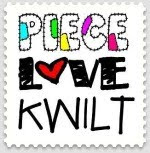i'm not going to go into "how-to" territory with this, there's books on the subject, and LQSs have classes all the time. i'm just going to tell you what experience has taught me. i have a feeling this is going to be one long blog post....
first i'm going to insert this from my POV as a LAer. it is not good to quilt certain paints that are used in screen printing (the rubbery ones). it is bad for my machine to quilt through the numbers on baseball/softball/basketball jerseys.embroidery can break needles. i can not quilt through puffy paint, buttons, sequins, and/or 3-d embellishments. if you can't get a needle through it, i can't LA through it. sweatshirts are thick. knitted sweaters are a PITA. keep this in mind when picking what shirts you put in your quilt, please. i understand you want to include every shirt that holds significance, but let's be honest, not every shirt can be in the quilt....pick the favorites.
DESIGN: you can be simple and cut all the shirts the same size and just sash and cornerstone. you can be complicated and do something 'fancy' it doesn't matter, but i would take the time to sit down and sketch your idea on graph paper. a t-shirt can be seen as a 'block' in a quilt, so look through sampler quilt books for different ideas for layouts. don't forget that the Internet is a library of info at your fingertips. go to goggle and search 'images' for "t-shirt quilt" and i guaranteed you'll get an inspiration before you get to the end of the images. webshots and flicr area good ones to look at/for pictures.
GETTING STARTED: the first thing you'll want to do is wash all the t-shirts in HOT water with NO fabric softener. fabric softener coats the fibers with a anti-stick residue, so your fusible stabilizer won't stick (that's bad) dry your shirts in the dryer with NO dry sheet- it's the same thing as fabric softener. it doesn't matter if the shirt has been worn or not- wash it!! we're not 'cleaning' the shirts, we're preparing them to be fused.
STABILIZER: there is a BIG difference between stabilizer and interfacing. stabilizer stabilizes and interfacing adds 'body' (think men's shirt collars) you want a lightweight fusible stabilizer. Pellon makes a nice woven fusible stabilizer, and i know there is a nice non-woven marketed for t-shirt quilts (dunno the name- sorry) you can find these at JoAnn's or Hancock's Fabric, basically anywhere they sell dress making stuff. keep in mind that when you buy it, you'll need a bigger piece than what you'll be cutting out for the shirts. (i.e. davis's t-shirts were cut at 20 1/2", so i figured a 25" square of stabilizer per shirt for yardage-figuring reasons) the top of the bolt will have all the info on it.
PREPARING THE SHIRTS: (i'm going to mention this here: if you haven't already got one- this is where a huge square ruler comes in handy. i have the Creative Grids 20 1/2" sq for this. trust me, you'll thank me for it later. have your LQS order it for you)
BEFORE CUTTING ANYTHING: measure the printed design of ALL the shirts you plan on using in the quilt. write them all down. you will cut all the shirts (plus seam allowance) the size as the BIGGEST designed shirt (if that's your plan, if not, i would suggest you make it your plan. life is too short for all that math) okay i hear someone "but, but"-ing. if you have smaller designs, like the little motif on the front chest, you can sew more than one together to make a bigger design (think 4patch or 9patch) or use them for border stones, or cornerstones, or add fabric borders to make it to size. (like i did in mine, upper right hand corner)
FUSING: this is how i did mine. you're welcome to do what is easier for you. i did it this way cause i know how i am, and wanted the biggest/most room for user error. first i cut the t-shirt up both sides to the arm hole seams. leaving the serged part of the seam attached to the body of the shirt, cut off the sleeves (these make the bestest dust rags) then cut across the shoulder seams giving you two pieces- front and back. lay the part with the design right side/painted side down on your ironing board. cut a piece of your stabilizer BIGGER than your finished size and fuse to the wrong side of the shirt. make sure that the stabilizer extends past where we will be cutting. let the shirt cool before moving it around too much. i slid them off and stacked them gently on my cutting table. i fused all my shirts at once, then i cut them all. follow the manufacturer's instructions on the stabilizer. watch that your iron isn't too hot, you might melt the paint on the shirt. try to always press the shirt from the wrong side, if you have to press it from the right side, avoid touching the paint/design area with the iron. iron only where you need to. if you're worried about it, a pressing/applique sheet will protect your iron from the paint on the shirt. the t-shirts might feel very stiff after being stabilized, but they will soften up.
CUTTING: using that big ruler, center your design and cut out to the predetermined size. take the shirt back to the ironing board and repress the edges from the wrong side. (press meanings moving the iron up and down, not scooting across the fabric) this double checks that the stabilizer is fused all the way to the edges. this may seem like a pain to do, but it's more of a pain when you start sewing and the fusible starts peeling off. it is frustrating to try to get it back on the shirt when the edges are rolling and it gets all out of shape.
SEWING: if possible press seam allowances away from the stabilized shirt. it's easier to piece with , it's easier to accurately press, and easier to quilt. seams don't need to be pressed open.
okay here's pictures of the two i've made with their stories.
 first my t-shirt quilt. i made it to show customers that quilting through the t-shirt didn't detract from the design. i originally had other plans for the design of the quilt, but they changed. i had cut out the shirts already, so they were all different sizes (bad,bad idea in hindsight) and sewn a 2" finished border to each. well, needless to say, i realized that wasn't going to work. so i had to do the math to sew another frame to each shirt to make them all the same size. (some were in 16ths of an inch) i did my curvy thing for the sashings, and opted for no border. i love this quilt. i have t-shirts collected for two more quilts. i need another WIP like another hole in the head.
first my t-shirt quilt. i made it to show customers that quilting through the t-shirt didn't detract from the design. i originally had other plans for the design of the quilt, but they changed. i had cut out the shirts already, so they were all different sizes (bad,bad idea in hindsight) and sewn a 2" finished border to each. well, needless to say, i realized that wasn't going to work. so i had to do the math to sew another frame to each shirt to make them all the same size. (some were in 16ths of an inch) i did my curvy thing for the sashings, and opted for no border. i love this quilt. i have t-shirts collected for two more quilts. i need another WIP like another hole in the head.it was juried into the ECQG quilt show 2007, and the judges really liked it based on their comments.
i like that it doesn't look like it's made from t-shirts.
it's a fun quilt with all my favorite fabrics from my stash. i think i only bought 2 fat quarters.
 now for davis's. i made it for him for christmas and i was very proud of myself- he didn't find out about it! that's a story in of itself. so keeping in mind all the lessons learned from my tshirt quilt, i planned a bit better on davis's. what i didn't count in for was how big the designs of the shirts were. thank goodness i had bought more fabric than i really needed, cause i ended up needing it. the shirts ended up being cut at 20 1/2" (i had figured on 16 1/2") i sewed a 2 1/2" cut border around each shirt, then cut my sashings at 2 1/2", that's why i think the quilt looks more complicated than it really is. i found a wood grain fabric, used that as the outer border and mitered the corners giving it a picture framed look. he loves it. he took it to work to show everybody.
now for davis's. i made it for him for christmas and i was very proud of myself- he didn't find out about it! that's a story in of itself. so keeping in mind all the lessons learned from my tshirt quilt, i planned a bit better on davis's. what i didn't count in for was how big the designs of the shirts were. thank goodness i had bought more fabric than i really needed, cause i ended up needing it. the shirts ended up being cut at 20 1/2" (i had figured on 16 1/2") i sewed a 2 1/2" cut border around each shirt, then cut my sashings at 2 1/2", that's why i think the quilt looks more complicated than it really is. i found a wood grain fabric, used that as the outer border and mitered the corners giving it a picture framed look. he loves it. he took it to work to show everybody. so with my i-did-this-the-way-wrong-and-should-of-done-it-like-this tips, i urge you to make a t-shirt quilt. it was fun! a t-shirt quilt isn't as 'serious' as a normal quilt, giving you opportunities to 'play'.




















Seems very interesting. Think u have got lots of collection regarding this. Hope you would share more things about this. Thanks for the post
ReplyDelete